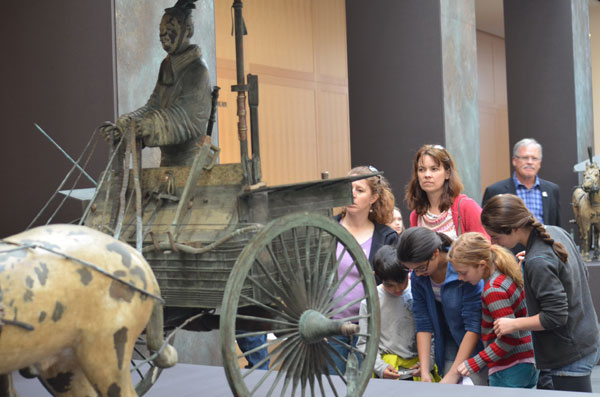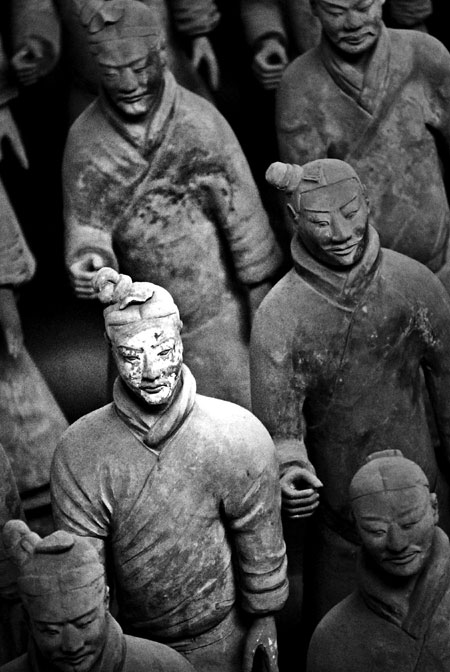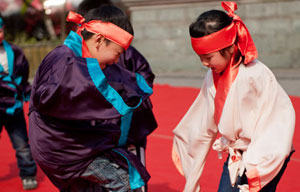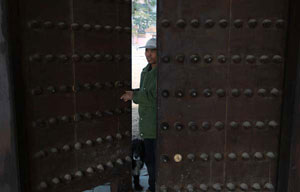
 'Taken 2' grabs movie box office crown
'Taken 2' grabs movie box office crown
 Rihanna's 'Diamonds' tops UK pop chart
Rihanna's 'Diamonds' tops UK pop chart
 Fans get look at vintage Rolling Stones
Fans get look at vintage Rolling Stones
 Celebrities attend Power of Women event
Celebrities attend Power of Women event
 Ang Lee breaks 'every rule' to make unlikely new Life of Pi film
Ang Lee breaks 'every rule' to make unlikely new Life of Pi film
 Rihanna almost thrown out of nightclub
Rihanna almost thrown out of nightclub
 'Dark Knight' wins weekend box office
'Dark Knight' wins weekend box office
 'Total Recall' stars gather in Beverly Hills
'Total Recall' stars gather in Beverly Hills
Warriors to the Golden Gate
Updated: 2013-04-08 10:40
By Chen Jia (China Daily)
|
|||||||||
 |
|
The ancient terracotta warriors are displayed in a new, modern way at the show China's Terracotta Warriors: The First Emperor's Legacy. [Photo/China Daily] |
 |
|
3-D image technology enables visitors to enjoy the show and get a better understanding of the relics.[Photo/China Daily] |
They were a Chinese emperor's elite guards, faithful to the last. China's most famous warriors are back in San Francisco, and Chen Jia is on site to record their adventures.
Returning to the City by the Bay for the first time in 20 years, China's Terracotta Warriors are striding into San Francisco, looking better than ever. This time, they will come alive with the help of 3-D image technology.
By spending a few minutes downloading an Apple app onto your iPad, iPhone or iPod Touch, and focusing the device on a poster for the exhibition at the Asian Art Museum, visitors can breathe life into this collection of terracotta sculptures that depict the armies of China's first emperor, Qin Shihuang (259-210 BC), and are known as the Eighth Wonder of the Ancient World.
But don't be surprised if a figure walks out of the picture. It's due to a process known as augmented reality (AR) technology that superimposes 3-D objects onto space.
"The idea of our approach to works of art is to bring them back to life. Connecting us to life," says Marco Centin, the exhibition designer who used multimedia and illustrations to create context around the artifacts.
His goal is to enhance the American visitors' understanding of the presentation, as well as to give it a more intuitive dimension.
"In other words, we want our visitors to not only enjoy the great beauty of the art works, but also the stories about them, and to imagine how they would have looked in their own time," the designer says.
The museum and Magma Studios, a Singapore-based games technology company, created the app together with the Asian Civilizations Museum, also of Singapore.
In 1985, the Shaanxi provincial cultural heritage bureau and the Minneapolis Institute of Arts collaborated on a small exhibition of the warriors, which were discovered by local farmers near Xi'an, Shaanxi's provincial capital, in 1974.
The exhibition's success encouraged exchanges between Shaanxi and Minnesota. About three years ago, MIA along with the Asian Art Museum extended an invitation to the Shaanxi cultural heritage bureau to organize China's Terracotta Warriors: The First Emperor's Legacy.
The institutions worked together on the exhibition for about two years.
"Some of the objects traveled for the first time outside China", so the "knowledge around them" is fresh, says Jay Xu, the director of the Asian Art Museum in San Francisco.
|
|
|
Most Viewed
Editor's Picks

|

|

|

|

|

|
Today's Top News
Boston bombing suspect reported cornered on boat
7.0-magnitude quake hits Sichuan
Cross-talk artist helps to spread the word
'Green' awareness levels drop in Beijing
Palace Museum spruces up
First couple on Time's list of most influential
H7N9 flu transmission studied
Trading channels 'need to broaden'
US Weekly

|

|










